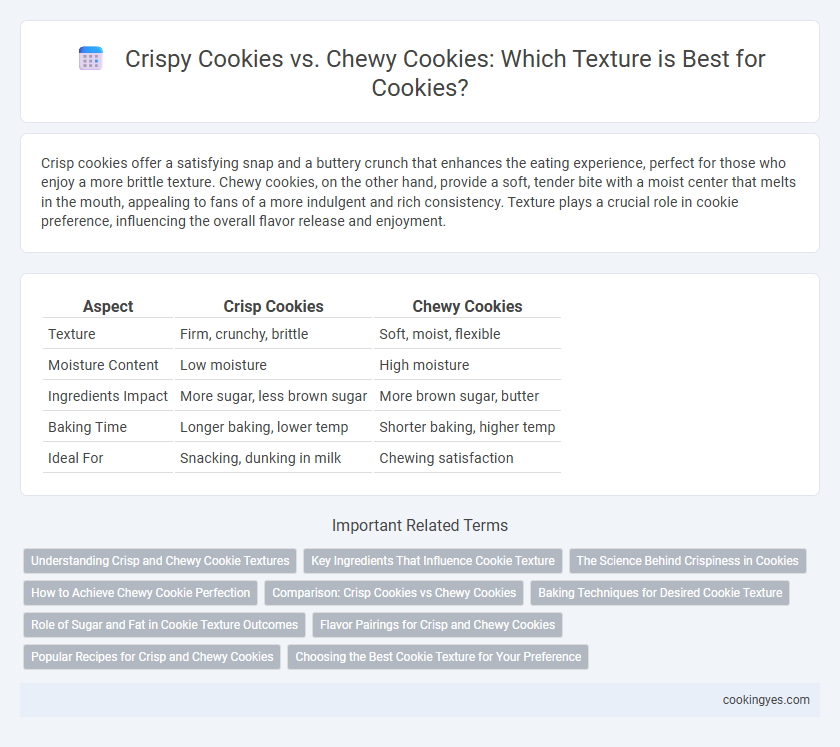Crisp cookies offer a satisfying snap and a buttery crunch that enhances the eating experience, perfect for those who enjoy a more brittle texture. Chewy cookies, on the other hand, provide a soft, tender bite with a moist center that melts in the mouth, appealing to fans of a more indulgent and rich consistency. Texture plays a crucial role in cookie preference, influencing the overall flavor release and enjoyment.
Table of Comparison
| Aspect | Crisp Cookies | Chewy Cookies |
|---|---|---|
| Texture | Firm, crunchy, brittle | Soft, moist, flexible |
| Moisture Content | Low moisture | High moisture |
| Ingredients Impact | More sugar, less brown sugar | More brown sugar, butter |
| Baking Time | Longer baking, lower temp | Shorter baking, higher temp |
| Ideal For | Snacking, dunking in milk | Chewing satisfaction |
Understanding Crisp and Chewy Cookie Textures
Crisp cookies have a lower moisture content, resulting in a firm, crunchy texture that breaks easily, often achieved by using more sugar and butter or baking at higher temperatures. Chewy cookies contain higher moisture and more brown sugar or molasses, providing a soft, dense bite that retains flexibility after baking. Understanding the balance of ingredients like flour type, fat, and baking time is crucial for mastering the distinct textures of crisp versus chewy cookies.
Key Ingredients That Influence Cookie Texture
Crisp cookies achieve their texture primarily through higher sugar content and the use of butter or shortening that promotes spread and moisture evaporation. Chewy cookies rely on ingredients like brown sugar and higher moisture content, along with egg yolks, which add chewiness by retaining water and creating a denser structure. The balance of flour type and mixing technique also plays a crucial role, with bread flour enhancing chewiness due to its higher protein content and thorough mixing developing more gluten.
The Science Behind Crispiness in Cookies
Crisp cookies achieve their texture through lower moisture content and higher baking temperatures, which cause the water to evaporate faster, creating a dry, brittle structure. The Maillard reaction and caramelization enhance flavor and contribute to the cookie's firm exterior. In contrast, chewy cookies retain more moisture and use ingredients like brown sugar and molasses that lock in moisture, preventing the cookie from becoming overly crisp.
How to Achieve Chewy Cookie Perfection
Achieving chewy cookie perfection requires balancing ingredients and baking time, emphasizing higher moisture content from brown sugar and eggs to retain softness. Using melted butter and slightly underbaking the cookies preserves a dense, tender texture that resists becoming crispy or crumbly. Baking at a moderate temperature around 350degF ensures even cooking while maintaining that signature chewy bite prized in bakery-style cookies.
Comparison: Crisp Cookies vs Chewy Cookies
Crisp cookies feature a crunchy texture with a golden-brown exterior achieved by baking at higher temperatures and using less moisture, ideal for those who enjoy a firm bite. Chewy cookies maintain a soft, dense interior, often containing higher moisture and brown sugar for a moist, pliable texture that enhances flavor retention. The choice between crisp and chewy cookies depends on personal preference for texture and how ingredients like fat, sugar, and baking time influence the final product.
Baking Techniques for Desired Cookie Texture
To achieve crisp cookies, incorporate higher baking temperatures and extend baking time slightly to evaporate more moisture, while using more granulated sugar and less brown sugar to reduce chewiness. For chewy cookies, lower oven temperatures and shorter baking durations help retain moisture, with a higher ratio of brown sugar and the addition of ingredients like corn syrup or honey to increase softness. Adjusting techniques such as chilling dough and using melted butter also impacts the final texture, enabling precise control over cookie crispiness or chewiness.
Role of Sugar and Fat in Cookie Texture Outcomes
The texture differences between crisp and chewy cookies primarily result from the ratio and type of sugar and fat used in the recipe. Granulated sugar promotes crispness by encouraging more spread and moisture evaporation, while brown sugar retains moisture, leading to a chewier texture. Similarly, butter yields a tender, chewy bite due to its water content and melting point, while shortening produces crisper cookies by limiting spread and moisture loss.
Flavor Pairings for Crisp and Chewy Cookies
Crisp cookies, with their brittle texture, pair exceptionally well with rich, buttery flavors and bright citrus notes that enhance their snap without overwhelming. Chewy cookies, featuring a soft, dense bite, complement deeper, indulgent ingredients like dark chocolate, caramel, and nuts to balance moisture and intensify taste. Both textures offer unique flavor profiles ideal for personalized dessert experiences and creative baking innovations.
Popular Recipes for Crisp and Chewy Cookies
Crisp cookies, such as classic biscotti and ginger snaps, feature a crunchy texture achieved through recipes with higher sugar and fat ratios, thinner dough, and longer baking times. Chewy cookies like chocolate chip or oatmeal raisin rely on moist ingredients, higher brown sugar content, and shorter baking durations to maintain a soft, tender center. Popular recipes for crisp cookies often include ingredients like granulated sugar and butter, while chewy cookie recipes emphasize brown sugar and molasses for moisture retention.
Choosing the Best Cookie Texture for Your Preference
Crisp cookies offer a firm, crunchy texture that enhances the experience for those who enjoy a snap with every bite, often preferred with thin, buttery recipes like biscotti or gingersnaps. Chewy cookies provide a soft, dense feel, retaining moisture and richness, making varieties like chocolate chip or molasses cookies ideal for a tender mouthfeel. Choosing the best cookie texture depends on personal preference for either a brittle crunch or a soft bite, influenced by ingredients such as butter content, sugar type, and baking time.
Crisp cookies vs Chewy cookies for texture Infographic

 cookingyes.com
cookingyes.com